Key Summary
- Australian universities rank higher globally (University of Melbourne at #14 QS ranking) compared to Chinese institutions, but China offers significantly lower tuition fees ranging from ¥15,000-¥90,000 ($2,100-$12,600) annually versus Australia’s AU$14,000-AU$37,000 ($9,300-$24,600).
- China provides more affordable living costs, with monthly rent averaging ¥2,191-¥7,900 compared to Australia’s AU$1,827-AU$3,775, though Australia permits 40 hours of weekly part-time work versus China’s 24 hours and offers easier pathways to permanent residency.
- Fresh graduates in Australia earn significantly higher salaries at AU$74,497 annually compared to China’s average monthly salary of ¥10,342 (approximately ¥124,000 annually), making Australia more financially rewarding despite higher education and living costs.
Choosing the right university and study-abroad destination is one of the most important decisions in your life. Your choice can either make or break your future, so it is important to pursue your education from the right place. For this very reason, countries like China and Australia attract tons of international students every year. Both nations house excellent universities, which are a stepping stone for a bright career. If you are confused about whether you should choose China or Australia to study abroad, then you are at the right place. We will clear all of your confusion regarding China vs Australia. We will judge each country based on a particular aspect and award +2 points to the one which is better in a particular aspect.
| Parameters | China | Australia |
| Area | 9.597 Million KM² | 7.688 Million KM² |
| Currency | Chinese Yuan (¥) | AUD (AU$) |
| Capital | Beijing | Canberra |
| Total Higher Education Providers | 3,012 | 170 |
| Total Indian Students Studying | 23,000 | 95,791 |
| Average Cost of Living | ¥4,047.3 | AU$2800 – AU$3000 Per Month |
| Average Cost of Studying | ¥18,249 – ¥72,996 Per Year | AU$20,000 – AU$50,000Per Year |
| Popular Job Sectors | Technology, Accountancy and Finance, Teaching, Medicine, Marketing, and Manufacturing | Information and Communication Technology (ICT), Healthcare and Medical, Architects, Professional Services – Technical & Scientific Area |
| Permitted Part-Time Working Hours | 24 Hours Per Week | 40 Hours Per Week |
This Blog Includes:
Top-Ranked Universities: China vs Australia
China and Australia are known for their high standard of education that positions the students for a thriving career. Let’s look at some of the highest-ranked universities in China and Australia in this section.
Universities in China
Here are some of the best universities in China:
| Top Universities in China | QS World University Rankings 2025 | Times Higher Education World University Rankings 2025/2026 |
| Peking University | #14 | #13 |
| Tsinghua University | #20 | #12 |
| Zhejiang University | #47 | #47 |
| Fudan University | #39 | ≈#36 |
| Shanghai Jiao Tong University | #45 | #52 |
| University of Science and Technology of China (USTC) | #133 | ≈#53 |
| Nanjing University | #145 | #65 |
| Wuhan University | #194 | ≈#134 |
| Tongji University | #192 | ≈#154 |
| Harbin Institute of Technology | #252 | ~outside top 300 |
Universities in Australia
The table below shows some of the top universities in Australia:
| Top Universities in Australia | QS World University Rankings 2025 | Times Higher Education World University Rankings 2025 |
| The University of Melbourne | 14 | 34 |
| The University of New South Wales (UNSW Sydney) | 19 | 71 |
| The University of Sydney | 18 | 54 |
| Australian National University (ANU) | 30 | 62 |
| Monash University | 37 | 44 |
| The University of Queensland (UQ) | 40 | 53 |
| The University of Western Australia (UWA) | 72 | 131 |
| The University of Adelaide | 89 | 88 |
| University of Technology Sydney (UTS) | 90 | 133 |
| Macquarie University | 130 | 192 |
Which Country is Better?
The tables above show that the universities in Australia are ranked higher than in China. Hence, we will grant +2 points to Australia in this round of China vs Australia.

Admission Requirements
In this section, we will understand the eligibility criteria for getting admission into Chinese and Australian universities. The country with the simpler admission requirements will win this round.
Admission Requirements For China
One needs to provide these listed documents to be considered eligible for admission into a university in China:
- Passport copy
- A photo (passport size)
- Personal statement
- Physical examination form- medical results
- Official transcripts
- 2 recommendation letters (should be written and signed by your teachers/professors and contain their contact details)
- Bank statement
- Graduation certificate (s)
Admission Requirements For Australia
You need to meet the criteria shown below to get admission to Australian universities:
- Students must score a minimum of 65% in their Class 12th examination.
- Applicants also have to provide a statement of purpose and a letter of recommendation.
- Students are also required to submit a curriculum vitae.
- They must ensure that they possess a valid visa to enter and pursue education in Australia.
- The applicants are required to have a minimum IELTS score of 5.5, a CAE score of 162, a TOEFL score of 46 (internet-based test), and a PTE Academic score of 42.
- They must also obtain Overseas Student Health Coverage (OSHC).
Which Country is Better?
While both China and Australia have straightforward admission criteria, China has slightly simpler requirements. Hence, we will give +2 points to China in this round of China vs Australia.
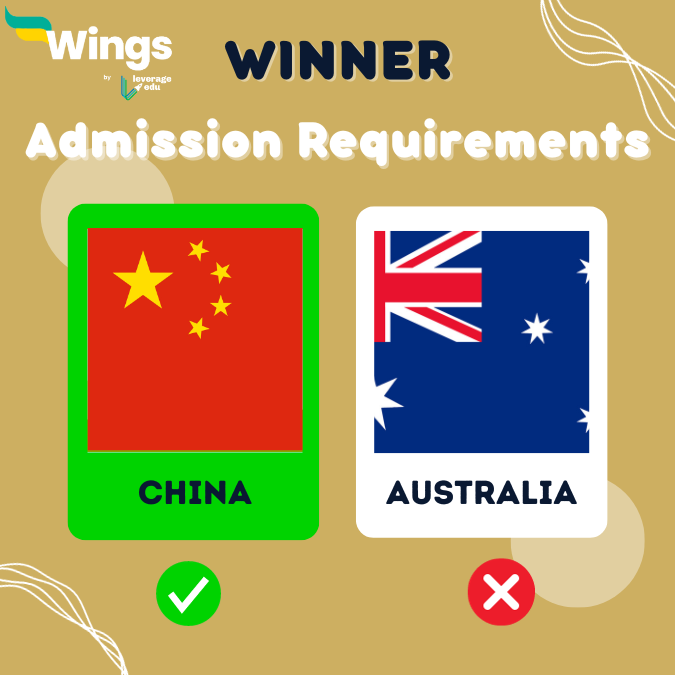
Tuition Fees
One should consider the educational costs as well while choosing a study destination. So, let’s compare China and Australia based on their cost of tuition.
Tuition Fees in China
The average tuition fees in China as per the websites of the universities in the country are shown below:
| Study Program | Average Annual Tuition Fee |
| Undergraduate | ¥15,000 to ¥60,000 |
| Postgraduate | ¥18,000 to ¥90,000 |
| Doctoral | ¥20,000 to ¥50,000 |
Tuition Fees in Australia
According to the websites of the Australian universities, the average annual tuition fees in the country are as follows:
| Study Program | Average Annual Tuition Fee |
| Undergraduate | AU$15,000 – AU$33,000 |
| Postgraduate | AU$14,000 – AU$37,000 |
| Doctoral | AU$14,000 – AU$37,000 |
Which Country is Better?
The tables shown above imply that the tuition fee in China is lower than in Australia. As a result, we will award +2 points to China in this round of China vs Australia.
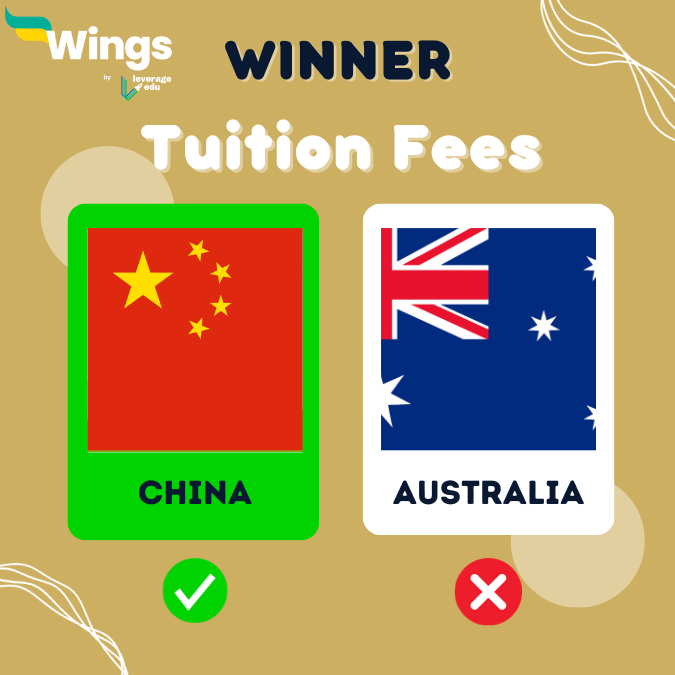
Also Read: China Medical University – Colleges, Courses, and More
Living Expenses
Another important consideration you should keep in mind is the cost of living at your study destination. So, let’s look at the cost of living in China and Australia.
Cost of Living in China
The living expenses in China as per Numbeo are shown in the table below:
| Monthly Rent | ¥2,191.31 – ¥7,900.84 |
| Average Apartment Price (Price per Square Metre) | ¥33,742.16 – ¥58,250.61 |
| Average Cost of an Inexpensive Restaurant Meal | ¥25 |
| Average Transportation Cost (Monthly) | ¥200 |
| Average Cost of Utility (Monthly) | ¥584.12 |
Cost of Living in Australia
According to Numbeo’s website, the cost of living in Australia is as follows:
| Monthly Rent | AU$1,827.31 – AU$3,775.63 |
| Average Apartment Price (Price per Square Metre) | AU$8,924.80 – AU$11,645.02 |
| Average Cost of an Inexpensive Restaurant Meal | AU$25 |
| Average Transportation Cost | AU$170.65 |
| Average Cost of Utility (Monthly) | AU$453.55 |
Which Country is Better?
The cost of living in China is lower than in Australia, and hence, China will receive +2 points in this round of China vs Australia.
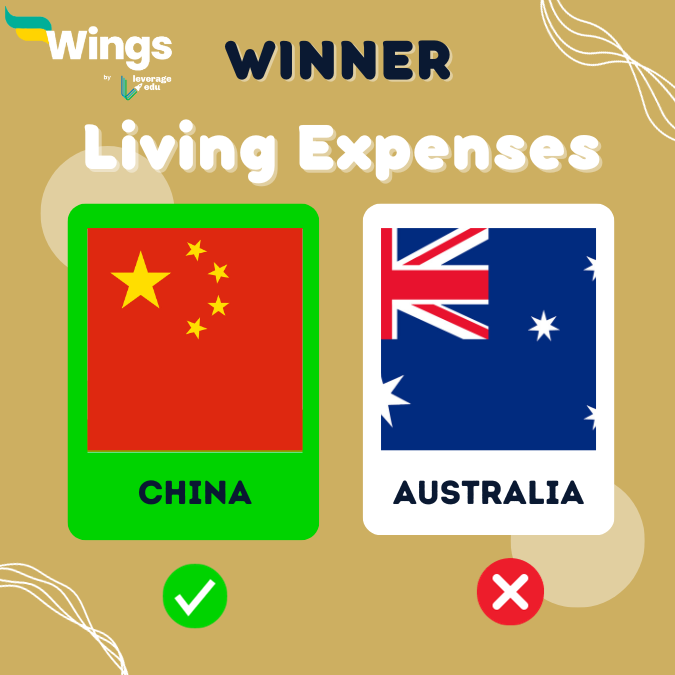
Work Permit and PR
If you want to find employment after graduation from your destination country and eventually settle there, then don’t skip this section. Here, we will judge China and Australia based on their ease of granting work permits and permanent residency.
Work Permit in China
Here is how the work permit is granted in China:
Eligibility Criteria to Get a Work Permit in China
Submit the documents given below to apply for a Chinese work permit:
- A valid passport,
- A completed application form,
- Reference letter,
- An approval document for commercial performances,
- Medical examination report from an authorized hospital,
- A passport-sized photograph,
- Registration Certificate of Resident Representative Offices of Enterprises from Foreign Countries,
- Clean criminal record,
- TEFL/TESOL certificate authenticated by the Chinese embassy or consulate (applicable only for teaching positions),
- Foreigners Work Permit notification letter issued by the Ministry of Human Resources and Social Security of the PRC, and
- Issued by the Chinese government authorities for Cultural Affairs.
To obtain the notification letter, Your employer has to provide the documents listed below to the Labour Bureau:
- Degree or diploma (legalised and authenticated),
- Proof of at least two years of work experience in the relevant field,
- Your resume,
- Verification of education or professional qualifications,
- A copy of the job contract,
- Information concerning any accompanying members,
- Verification of employment history, and
- Physical examination record.
Steps to Apply for a Chinese Work Permit
Follow the steps given below to obtain a Chinese Work Permit:
Step 1: Make sure that you have been given a job offer in China.
Step 2: Once you have successfully got a job, collect and prepare all the necessary documentation.
Step 3: Now, proceed with your application by applying for a work visa at a Chinese embassy, and pay the application fees.
Step 4: Finally, you will be awarded your work visa after you have completed the application process.
The processing time for a Chinese work visa is typically around 4 working days, depending on the quantity of applications the embassy gets.
PR in China
You can receive a permanent residency visa regardless of your employer or post if you:
- Pay your income taxes timely (¥120,000 or more yearly),
- Earn an annual salary of more than ¥600,000, and
- Have worked in Shanghai for more than a period of four years and don’t have any criminal record in the country of your residence.
Work Permit in Australia
The processing time for a work visa in Australia usually takes roughly 2-8 months. However, the work visa’s processing time depends on the visa type. TSS visa (Temporary Skill Shortage), Skilled Independent visa, and Employer Nomination Scheme (ENS) visa are some of the work visas you can apply for in Australia.
Eligibility Criteria to Get a Work Permit in Australia
Here are the eligibility requirements for getting a work permit in Australia:
- The age of the applicant should not be more than 45 years old.
- The candidate must possess the necessary skills and work experience of a minimum of 3 years.
- Additionally, the candidate has to meet health and character standards.
Steps to Apply for an Australian Work Permit
Here is a step-by-step procedure to apply for an employee work visa in Australia:
Step 1: Visit the official website of the Australian Government’s Department of Home Affairs.
Step 2: Proceed with filling out the form for the visa type you want to apply for.
Step 3: Now, see if your profession is given on the list of skilled occupations for Skilled Visas.
Step 4: Obtain a nomination from an approved work sponsor before you take the appearance skills exam for sponsored visas.
Step 5: Then, go ahead and submit an Expression of Interest (EOI) to SkillSelect.
Step 6: You have to first receive an invitation to apply for this visa.
Step 7: Ensure that you gather and prepare all of your paperwork.
Step 8: Now, apply for a visa within 60 days of getting the invitation.
PR in Australia
The Australian PR process has three parts:
- Skill Evaluation in Australia: A designated skill assessment authority conducts the Skill evaluation in Australia.
- Australia PR Visa Approval: The DHA thoroughly goes through your profile once you have submitted the mandatory documentation. If you fulfil their special standards, you will be provided a visa.
- Preparation for Departure: If the applicant is given an Australian PR visa, he or she has to move to Australia by the first entry date written on the visa grant letter.
Which Country is Better?
It is apparent from above that obtaining a work permit and PR is easier in Australia than in China. Henceforth, Australia will get +2 points in this round of China vs Australia.

Also Read: PTE Score for Australian Student Visa
Average Salaries: China vs Australia
A fresh graduate earns an average monthly salary of ¥10,342 in China, as noted by TeamedUp China. Coming to Australia, the average annual salary is AU$ 74,497 in the country after graduation.
Which Country is Better?
The average salary earned in Australia is more than in China. So, we will award +2 points to Australia in this round of China vs Australia.

Other Major Elements
Small considerations such as climate and safety are also very crucial. Let’s look at some other key elements that decide whether a nation is suitable for you or not.
Climate
Located in the temperate climate zone, the majority of the regions in China are cool, but the southern part is hot and its northern region is quite frigid. Australia, on the other hand, experiences different climatic conditions. Hence it has diverse areas, which range from tropical rainforests to golden beaches.
Safety
China is a very safe country, you just need to ensure that you are aware of their local rules and understand their culture. Similarly, Australia is renowned for being a very safe nation for international students. Crimes like murder and narcotics are rare here.
Culture for International Students
International students in China often report a very gratifying and amazing experience. However, they may have to culturally adapt and understand the local language if they desire a better experience.
Also Read: Best Universities in Australia for International Students 2024
Conclusion
After calculating the total scores, we find that both China and Australia have received 6 points each. So, it’s a tie between China and Australia.
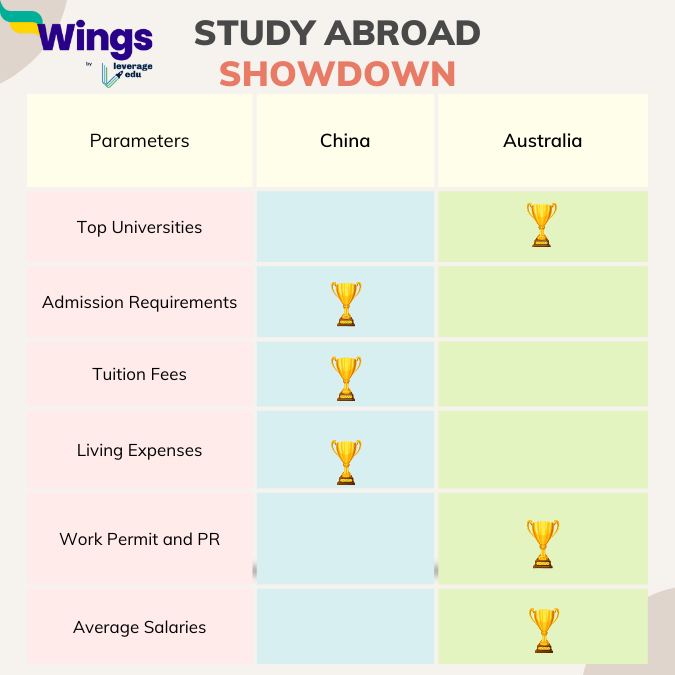
However, you should note that both countries are ideal for the pursuit of higher education. Your choice depends on various things, such as your budget and personal preferences.

FAQs
Ans. Both China and Australia are very important and major international exporters across the world.
Ans. Australia is a highly developed country which has overtaken the US in several areas and lags in others.
Ans. While Chinese universities offer affordable education, they are not completely free of education costs.
Related Articles:
So, this was all about China vs Australia. Many Indian students dream of pursuing education in foreign nations due to the exposure and career growth they offer. Consider joining a free counselling session with Leverage Edu if you plan to study abroad.
 One app for all your study abroad needs
One app for all your study abroad needs














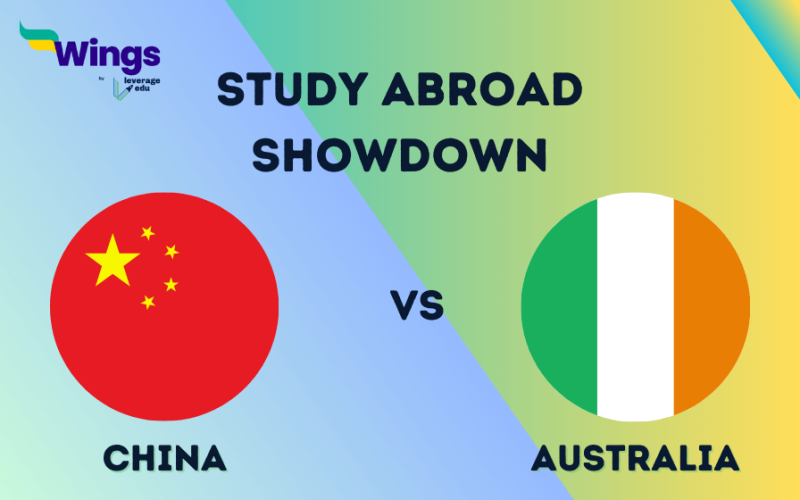
 60,000+ students trusted us with their dreams. Take the first step today!
60,000+ students trusted us with their dreams. Take the first step today!